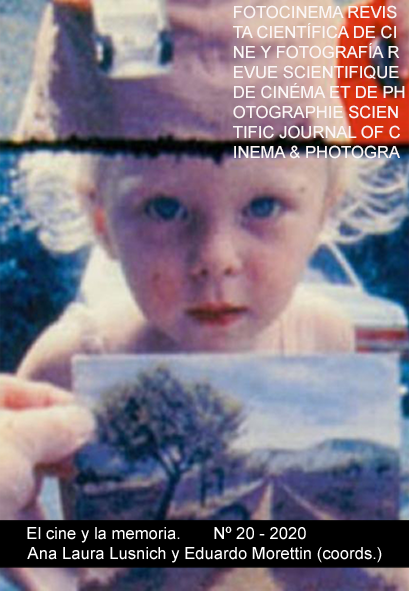Uruguay, Chile and the rescue of magnetic memories
DOI:
https://doi.org/10.24310/Fotocinema.2020.v0i20.7604Keywords:
Uruguay, Chile, Video, Transition, Audiovisual Rescue, ArchivesAbstract
Based on the rescue of two films, an Uruguayan and a Chilean one, both filmed in Chile, in U-matic format in the late eighties, this article aims at showing some aspects of the period linking political contexts with audiovisual technology, together with exhibition and reception spaces. It also refers to the fact that these documents are accessible in a public archive are therefore available to researches of transitions back to democracies in the two countries under consideration.
Downloads
Metrics
References
Balás, M. (2018) ¿Reconocer o conocer a través de las pantallas? El CEMA y las estrategias para llegar más allá de fronteras. En G. Torello. (Ed.), Uruguay se filma. Prácticas documentales (1920-1990) (pp.195-217). Montevideo: Irrupciones.
Caetano, G. y Rilla, J. (2017). Breve historia de la dictadura. Montevideo: Banda Oriental (primera edición 1987).
Chanan, M. (2003). El documental y la esfera pública en América Latina. Notas sobre la situación actual de América Latina comparada con cualquier otro sitio. Revista Secuencias, nº 18. En línea: https://revistas.uam.es/secuencias/article/view/4161/4468
Didi-Huberman, G. (2018). Cuando las imágenes tocan lo real. Madrid: Círculo de Bellas Artes.
Dinamarca, H. (1990). El video en América Latina. Actor innovador del espacio audiovisual. En H. Dinamarca, (coord.), Experiencias en el espacio audiovisual. Argentina, Brasil, Chile, Uruguay. Montevideo: Centro de Medios Audiovisuales (CEMA), Instituto de Comunicación y Desarrollo (ICD), FCU.
Gárate, A. y Rovano, J. (2002) Teleanálisis: el registro no oficial de una época. (Tesis para optar al grado de Licenciado en Comunicación social). Santiago de Chile: Universidad Diego Portales. Facultad de Ciencias de la comunicación e información. Escuela de periodismo.
Getino, O. (1989). Video Latinoamericano: los lazos de la imagen. En M. Gutiérrez. Video, tecnología y comunicación popular (pp.129-140). Perú: IPAL.
Góngora, A. (1989) Las imágenes de un país invisible. En M. Gutiérrez. Video, tecnología y comunicación popular (119-127). Perú: IPAL.
Góngora, A. (1987) Periodismo en TV. En JP. Lira (Comp.) Televisión en Chile: un desafío nacional (pp. 224-226). Santiago. CED-CENECA.
Groys, B. (2016). Bajo sospecha. Valencia: Pretextos.
Guntín, J.L. (2010). La vida te da sorpresas, Montevideo: Fin de siglo.
Gutiérrez, M. (1989) Video, tecnología y comunicación popular. Perú: IPAL.
Liñero Arend, G. (2010) Apuntes para una historia del video en Chile. Santiago de Chile: Ocho libros Editores.
Marchesi, A. (2019). Hacer la revolución. Guerrillas latinoamericanas de los años sesenta a la caída del Muro. Montevideo: Siglo XXI.
Marchesi, A. (2001). El Uruguay inventado. La política audiovisual de la dictadura, reflexiones su imaginario. Montevideo: Trilce.
Moulian, T. (1997). Chile actual: anatomía de un mito. Santiago: Lom-ARCIS.
Secco, L. (2016) Los intelectuales y la televisión durante la primera década de ese medio en Uruguay. Claves. Revista de Historia, vol. 2, nº 3 Montevideo, Julio-Diciembre (pp. 163-191) ISSN 2393-6584
Tadeo Fuica, B. (2017). Uruguayan cinema, 1960-2010. Text, materiality, archive. Woodbridge: Támesis.
Tadeo Fuica, B. y Balás, M. (2016). CEMA: archivo, video y restauración democrática. Montevideo: ICAU-FIC.
Valdeavellano, P. (Ed.). (1989) El video en la educación popular. IPAL, CEDAL.
Downloads
Published
How to Cite
Issue
Section
License
All contents published in Fotocinema Revista científica de cine y fotografía are protected under the Creative Commons Attribution-NonCommercial-ShareAlike 4.0 International (CC BY-NC-SA 4.0) license. All about this license is available in the following link: <http://creativecommons.org/licenses/by-nc-sa/4.0>
Users can copy, use, redistribute, share and exhibit publicly as long as:
- The original source and authorship of the material are cited (Journal, Publisher and URL of the work).
- It is not used for comercial purposes.
- The existence of the license and its especifications are mentioned.
There are two sets of authors’ rights: moral and property rights. Moral rights are perpetual prerogatives, unrenounceable, not-transferable, unalienable, imprescriptible and inembargable. According to authors’ rights legislation, Fotocinema. Revista científica de cine y fotografía recognizes and respects authors moral rights, as well as the ownership of property rights, which will be transferred to University of Malaga in open access. The property rights are referred to the benefits that are gained by the use or the dissemination of works. Fotocinema. Revista científica de cine y fotografía is published in an open access form and it is exclusively licenced by any means for doing or authorising distribution, dissemination, reproduction, , adaptation, translation or arrangement of works.
Authors are responsable for obtaining the necessary permission to use copyrighted images.













13.png)




